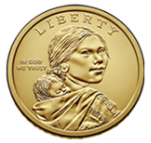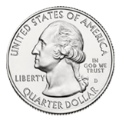20.1: What Are Percentages?
( \newcommand{\kernel}{\mathrm{null}\,}\)
Lesson
Let's learn about percentages.
Exercise
Find each answer mentally.
- A sticker costs 25 cents. How many dollars is that?
- A pen costs 1.50 dollars. How many cents is that?
- How many cents are in one dollar?
- How many dollars are in one cent?
Exercise
- Complete the table to show the values of these U.S. coins.

| coin | penny | nickel | dime | quarter | half dollar | dollar |
|---|---|---|---|---|---|---|
| value (cents) |
The value of a quarter is 25% of the value of a dollar because there are 25 cents for every 100 cents.

- Write the name of the coin that matches each expression.
- 25% of a dollar
- 5% of a dollar
- 1% of a dollar
- 100% of a dollar
- 10% of a dollar
- 50% of a dollar
- The value of 6 dimes is what percent of the value of a dollar?
- The value of 6 quarters is what percent of the value of a dollar?
Are you ready for more?
Find two different sets of coins that each make 120% of a dollar, where no type of coin is in both sets.
Exercise

A $1 coin is worth 100% of the value of a dollar. Here is a double number line that shows this.

- The coins in Jada’s pocket are worth 75% of a dollar. How much are they worth (in dollars)?
- The coins in Diego’s pocket are worth 150% of a dollar. How much are they worth (in dollars)?
- Elena has 3 quarters and 5 dimes. What percentage of a dollar does she have?
Summary
A percentage is a rate per 100.
We can find percentages of $10 using a double number line where 10 and 100% are aligned, as shown here:

Looking at the double number line, we can see that $5.00 is 50% of $10.00 and that $12.50 is 125% of $10.00.
Glossary Entries
Definition: Percent
The word percent means “for each 100.” The symbol for percent is %.
For example, a quarter is worth 25 cents, and a dollar is worth 100 cents. We can say that a quarter is worth 25% of a dollar.


Definition: Percentage
A percentage is a rate per 100.
For example, a fish tank can hold 36 liters. Right now there is 27 liters of water in the tank. The percentage of the tank that is full is 75%.

Practice
Exercise
What percentage of a dollar is the value of each coin combination?
Exercise
- List three different combinations of coins, each with a value of 30% of a dollar.
- List two different combinations of coins, each with a value of 140% of a dollar.
Exercise
The United States government used to make coins of many different values. For each coin, state its worth as a percentage of $1.

Exercise
Complete the double number to line show percentages of $50.

Exercise
Elena bought 8 tokens for $4.40. At this rate:
- How many tokens could she buy with $6.05?
- How much do 19 tokens cost?
(From Unit 3.3.5)
Exercise
A snail travels 10 cm in 4 minutes. At this rate:
- How long will it take the snail to travel 24 cm?
- How far does the snail travel in 6 minutes?
(From Unit 3.3.4)
Exercise
- 3 tacos cost $18. Complete the table to show the cost of 4, 5, and 6 tacos at the same rate.
number of tacos cost in dollars rate in dollars per taco Table - If you buy
(From Unit 3.3.3)

